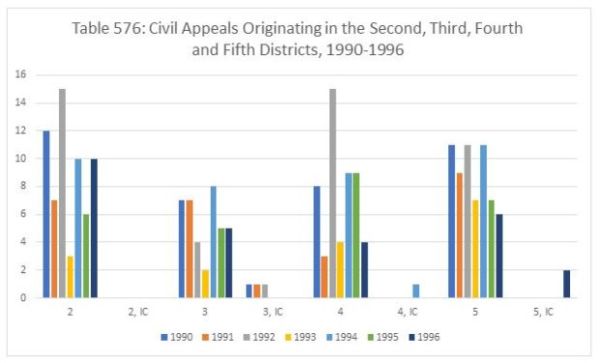This week, we answer a new question in our study of the expanded Illinois Supreme Court data library: how have the Court's civil cases been distributed among the various parts of the Appellate Court?
As of 1990, Cook County accounted for 44.66% of the total population of Illinois. So if caseload followed population distribution, one would expect 39-40 of the Court's 89 civil cases to have originated in the First District. But based solely on population, the First District has been consistently underrepresented in the civil docket, accounting for 30 cases in 1990, 21 in 1991, 34 in 1992, 19 in 1993, 28 in 1994, 24 in 1995 and 18 in 1996. More specifically, Division One produced three cases each in 1990 and 1991, two in 1992, none in 1993, six in 1994, three in 1995 and two in 1996. Division Two produced three cases in 1990, six in 1991, four in 1992, one in 1993, seven in 1994 and one each in 1995 and 1996. Division Three produced a dozen civil cases in 1990, but only two in 1991; six in 1992 and 1994, four in 1993 and five each in 1995 and 1996. Division Four produced seven cases in 1990 and 1992, five each in 1991, 1993 and 1994, and two per year in 1995 and 1996. Division Five produced two cases in 1990, 1994 and 1995, three cases in 1994, four in 1992, five in 1993 and none in 1996. Division Six produced no civil cases in 1990 and 1993, one per year in 1991 and 1994, five apiece in 1995 and 1996 and seven in 1993. The Industrial Commission panel of the First District produced two cases in 1995. I was unable to assign a total of twenty cases to a specific District of Division One (almost always because the Appellate Court issued a Rule 23 order and there were no identifying characteristics in the Supreme Court opinion): three in 1990, one in 1991, four each in 1992 and 1993, one in 1994, four in 1995 and three in 1996.

Just as the First District was arguably underrepresented on the Court's docket during these years, the rest of the state was arguably overrepresented. In 1990, the Court decid3ed twelve civil cases from the Second District, seven from the Third, one from the Industrial Commission Division of the Third District, eight from the Fourth District and eleven from the Fifth District. For the most part, this distribution of the caseload stayed constant from one year to the next. The Second District produced seven cases in 1991, only three in 1993 and six in 1995, but 15 in 1992 and ten each in 1994 and 1996. The Third District produced seven cases in 1991, four in 1992, two in 1993, eight in 1994 and five per year in 1995 and 1996. The Fourth District produced only three cases in 1991 and four in 1993 and 1996, but nine each year in 1994 and 1995, and accounted for fifteen cases in 1992. The Fifth District, frequently criticized by defense bar advocates of tort reform, generally claims an outsized piece of the Court's civil docket in terms of population. It produced nine cases in 1991, eleven in 1992 and again in 1994, seven per year in 1993 and 1995 and six in 1996.

In Table 577, we report the remaining miscellaneous civil appeals. In 1990, the Court decided twelve direct appeals from the Circuit Courts (typically, constitutional issues), four original proceedings and four attorney admission/disciplinary issues. In 1991, the Court heard only four direct appeals and one original proceeding. In 1992, the Court decided seven direct appeals, one original proceeding, one bar matter and two certified questions from the Seventh Circuit. In 1993, the Court decided only three direct appeals in civil cases. In 1994, the Court decided seven direct appeals and one original proceeding. In 1995, the Court decided three direct appeals and one original proceeding. Finally, in 1996, the Court decided ten direct appeals in civil cases.

Join us back here tomorrow as we review the Court's civil cases from 1997 through 2003.
The content of this article is intended to provide a general guide to the subject matter. Specialist advice should be sought about your specific circumstances.


